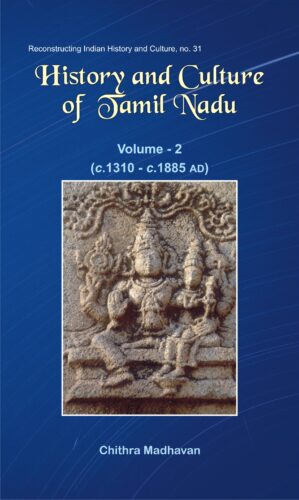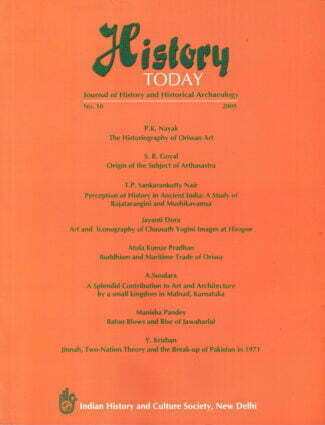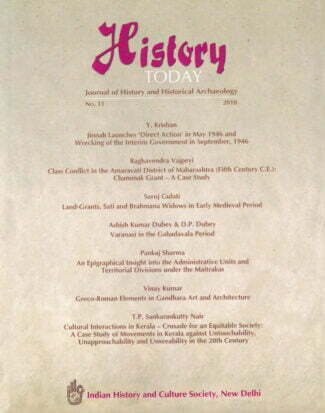Showing 51–60 of 196 results

A comprehensive work on chaste Sanskrit inscriptions of ancient Tamil Nadu, under Pallavas, Pandavas, Coëas and their vassals; focussing on the then prevalent socio-economic, literary, religio-cultural and administrative paradigms. A valuable contribution to the field of epigraphy and history of Tamil Nadu.
Inscriptions are the most authentic and vital source for reconstructing the history of India. Epigraphs were composed in Sanskrit in various parts of India and the ancient Tamil country was no exception to this practice. Among the thousands of epigraphs found all over Tamil Nadu, a large number are composed in chaste Sanskrit and these as well as the Sanskrit portions of the bi-lingual copper-plate records serve as an important source of data about the conditions which existed in the ancient Tamil country. These Sanskrit inscriptions are also excellent pieces of prose and poetry and reveal the high standard which this language had attained in the ancient past in the Tamil country. This is a comprehensive and interesting work dealing with the Sanskrit inscriptions of ancient Tamil Nadu belonging to the period of the Pallavas, Pandyas and Colas and their vassals. It focuses attention on aspects of civil and military administration, social and economic life, education, literature and also the religious and cultural conditions of those ages. These inscriptions serve to highlight the cultural richness which Tamil Nadu enjoyed specially under the Pallavas, Pandyas and Colas. This book is a valuable contribution to the field of epigraphy and to the history of Tamil Nadu.

A comprehensive work on chaste Sanskrit inscriptions of ancient Tamil Nadu, under Pallavas, Pandavas, Coëas and their vassals; focussing on the then prevalent socio-economic, literary, religio-cultural and administrative paradigms. A valuable contribution to the field of epigraphy and history of Tamil Nadu.
Inscriptions are the most authentic and vital source for reconstructing the history of India. Epigraphs were composed in Sanskrit in various parts of India and the ancient Tamil country was no exception to this practice. Among the thousands of epigraphs found all over Tamil Nadu, a large number are composed in chaste Sanskrit and these as well as the Sanskrit portions of the bi-lingual copper-plate records serve as an important source of data about the conditions which existed in the ancient Tamil country. These Sanskrit inscriptions are also excellent pieces of prose and poetry and reveal the high standard which this language had attained in the ancient past in the Tamil country. This is a comprehensive and interesting work dealing with the Sanskrit inscriptions of ancient Tamil Nadu belonging to the period of the Pallavas, Pandyas and Colas and their vassals. It focuses attention on aspects of civil and military administration, social and economic life, education, literature and also the religious and cultural conditions of those ages. These inscriptions serve to highlight the cultural richness which Tamil Nadu enjoyed specially under the Pallavas, Pandyas and Colas. This book is a valuable contribution to the field of epigraphy and to the history of Tamil Nadu.

A comprehensive work on chaste Sanskrit inscriptions of ancient Tamil Nadu, under Pallavas, Pandyas, Colas and their vassals; focusing on the then prevalent socio-economic, literary, religio-cultural and adminstrative paradigms. A valuable contribution to the field of epigraphy and history of Tamil Nadu.
Epigraphy, or the study of inscriptions, has played a very important role in reconstructing the history of India. Tamil Nadu in particular has a very large number of epigraphs, which have been of immense help to historians in writing about the history of the Tamil country. The majority of these inscriptions are written in Tamil. However, beginning from the sixth century ad, a large number of inscriptions, both lithic and copper-plate grants came to be composed in Sanskrit as well. Some of these epigraphs are wholly in Sanskrit while some, especially the copper-plate inscriptions, are bi-lingual, with the first or prashasti portion in chaste Sanskrit and the second or operative part of the record being in Tamil.

A comprehensive work on chaste Sanskrit inscriptions of ancient Tamil Nadu, under Pallavas, Pandyas, Colas and their vassals; focusing on the then prevalent socio-economic, literary, religio-cultural and adminstrative paradigms. A valuable contribution to the field of epigraphy and history of Tamil Nadu.
Epigraphy, or the study of inscriptions, has played a very important role in reconstructing the history of India. Tamil Nadu in particular has a very large number of epigraphs, which have been of immense help to historians in writing about the history of the Tamil country. The majority of these inscriptions are written in Tamil. However, beginning from the sixth century ad, a large number of inscriptions, both lithic and copper-plate grants came to be composed in Sanskrit as well. Some of these epigraphs are wholly in Sanskrit while some, especially the copper-plate inscriptions, are bi-lingual, with the first or prashasti portion in chaste Sanskrit and the second or operative part of the record being in Tamil.
The experiences and knowledge from our past are recorded in manuscripts which have been handed down to us over several thousand years. The Government of India, through the Department of Culture, took note of the importance of this vast tangible heritage and, in order to preserve and conserve as well as to make access to this wealth easy, established the National Mission for Manuscripts (NMM). In order to disseminate the knowledge content of manuscripts, the Mission has taken up several programmes such as lectures, seminars and workshops. The Mission has published the proceedings of the above-said programmes under the following series: “Samiksika” (on conservation), “Tattvabodha” (comprising lectures based on manuscripts delivered by eminent scholars), “Samiksika” (research-oriented papers presented in the seminars), “Krtibodha” (transcribed and edited texts prepared at advanced level manuscriptology workshops conducted by NMM) and “Prakasika” (publication of rare, unpublished manuscripts). The present work, Samiksika-16 comprises the proceedings of the conference on History and Development of Mathematics held in the Samskrita Academy, Chennai in collaboration with the National Mission for Manuscripts.

The book deals with the beginnings of Jainism and its doctrines and beliefs, its spread and preachings of the tirthankaras as well as its contribution to Indias culture and art heritage. Based on original sources and with numerous illustrations, it focuses upon Jainism in the specific context of Mathura.
As one of the worlds major religions, founded on the spiritual principles of ahimsa (non-violence), truth, and righteous conduct, Jainism has today 2,600 years of a splendid living tradition with a well-defined worldview, metaphysics and code of ethics. A leading scholar, V.K. Sharma here presents an altogether fresh, pan-Indian historical survey of this great religion, spelling out its beginnings, antiquity, doctrines, tirthamkaras, country-wide spread and, among other aspects, its contribution to Indias culture and art heritage in all its varied manifestations. In the latter part of the book, the author comes to focus upon Jainism in the specific contexts of Mathura one of Indias ancient cities, which not only is venerated as the legendary birthplace of Lord Krishna, but is also famed as an eminent centre of Brahmanical, Buddhist and Jaina art. Thus shows Dr. Sharma how this principal Vaishnava centre today had been a stronghold of Jainism: from c. second century bc to about eleventh century ad; how it has contributed to Jaina canon, literature and iconography; and how in Mathura is traceable the centuries-long, unbroken history of Jaina plastic art. Setting out a panoramic view of Jaina architecture, sculptural art, and socio-religious life over the ages, specially in the sacred city of Mathura, this study is based on wide-ranging authoritative sources and supplemented by a number of highly representatives illustrations.

This book, presented in three parts, surveys the history of the Jaina dharma, its expansion under the Mauryas and Kharawelas, its nourishment by Cauhana, Paramara, Calukya, Rastrakuta and Ganga Kingdoms, its profound influence on life in India, particularly during the middle ages, and its survival during the Muslim rule.
History of Jainism has been presented here in three parts. The first part tries to prove through the archaeological and literary sources the historicity of Tirthankara, Parshvanatha and Mahavira, explaining their life and education besides religious, political, social, artistic and literary conditions of their times.
The second part surveys the history of the Jaina dharma, its expansion and significance. The effects of Jaina dharma increased when Mauryas were ruling Magadha and Kharawelas ruled Orissa. No doubt, the period from the ninth to twelfth centuries ce was a golden time in the history of Jainism and even traders, labourers and craftsmen were highly influenced by it during Kushana period. Seen geographically, Cauhana, Paramara and Calukya were acting as watchmen for Jainism in the north, and in the south it was being nourished by Rashtrakuta and Ganga (Kingdoms). Many Jaina temples were constructed, and monuments erected in honour of their deities. This part illustrates the many ways in which Jainism was served by the Jaina monks, saints, scholars and the politicians and answers questions such as: What kind of religious and social unions were made after the division and what were their traditional characteristics? How were the different leagues and monasteries of Jaina sages made? What was the lineage of various castes and how it originated?
The third part, associated with the middle ages of Jainism, describes that even though there was Muslim rule, still many organizations were sponsored with the influence of Jainism. Truthfully, there was a decline in Jainism during the middle ages but it remained protected. Many pilgrimages and historical places were established with the great influence of Jainism. Dr A.H. Nizami has written here about the Muslim reign, conditions of Jainism and also about the admirable Jainas. Dr Surendra Gopal has described the social and financial conditions prevailing during this period. Dr Shyam Sunder Nigam has penned on the Middle Ages of India and Dr Prakash Chandra Jain has written about the Jaina religion in the Middle Ages in Malwa region.
This monumental work will be a treat for the minds and eyes of people curious about Jainism.

An annual journal of the Indian History and Culture Society, has able to found its niche in the scholars of Indian history in a short span of four years. It carries fascinating, meticulously documented studies unveiling the treasure of historical facts in all its variegated evolutionary expressions and presenting fresh approaches to understanding and interpreting historical information and evidences. Which significantly contribute in apprising the readers about the history of India.
History Today, the journal of the 28-year-old Indian History and Culture Society, is devoted to History and Historical Archaeology. So far, five volumes of this journal and seven volumes of its proceedings have been published. The eminent historians who have been closely connected with it are Prefessors G.C. Pande, Devahuti, D.P. Singhal, A.K. Narain, B.P. Sinha, T.V. Mahalingam, R.C. Majumdar, V.V. Mirashi, K.D. Bajpai, T.K. Ravindran, A.V. Narasimhamurthy, A. Sundara, K.S. Lal, B.N. Mukherji, Mani Kamerkar, K.V. Raman, D.N. Tripathi, Ajaya Mitra Shastri, Lallanji Gopal, M.G.S. Narayanan, R. Nath, V.S. Pathak, Satish Mittal, G. Khurana, A.R. Khan, Y. Krishan, Sudha Mallaya, Vandana Kaushik, Sulochana Radhakrishanan, Rajesh Jamindar, Sunil Gupta, D.V. Sharma and many others whose contributions are well-known all over the world. The subjects covered in the articles published in these volumes include the history and archeology of not only the Ancient Period but also Medieval and Modern periods of Indian history. The papers are theoretical, HH analytical, critical, debatable, controversial and source-meterial oriented. Historical archaeology, including those concerning Early Historical and Medieval periods, also finds an important place in this journal. The subjects covered in this journal are Literature, Linguistics, Education, Anthropology, Tradition, Religion, Culture, Society, Economics, Art, Architecture, Folklore and other related disciplines. Thus, the canvas of this journal is very vast and every one interested in Indian history and historical archeology in Indian history and historical archaeology stands to benefit immensely from this journal.

History Today is a journal devoted to History, Historical Archaeology, Studies of Manuscripts, Education, Literature, Linguistics, etc. The present volume is a reprint of an earlier issue containing ten articles written by eminent historians and art lovers.
History Today is an official organ of the Indian History and Culture Society that is sincerely and single-mindedly devoted to history, historical archaeology, studies of manuscripts, education, literature, linguistics, etc.
The present volume, being a reprint of an earlier issue, contains eight articles written by eminent historians and art lovers. The subjects vary from Pattern of Urban Growth in northern India; shifting contours of Temple Patronage in Rajasthan; Tawaif and Khawas in erstwhile Hyderabad State; Islam and Islamic Iconoclasm in India; Prof. Habibs reaction to ASIs Report on Ayodhya; a critique of Habibs reaction; Rejection of Caste Inequalities by the Sikh Gurus; and use of Plastering Materials in Ancient India. The volume also carries Notes, News and New Source Material on the above topics.
The annual History Today journal has already published eight issues consecutively and has received high acclaim among historians, researchers and students.

History Today is a journal devoted to History, Historical Archaeology, Studies of Manuscripts, Education, Literature, Linguistics, etc. The present volume is a reprint of an earlier issue containing ten articles written by eminent historians and art lovers.
History Today is an official organ of the Indian History and Culture Society that is sincerely and single-mindedly devoted to history, historical archaeology, studies of manuscripts, education, literature, linguistics, etc.
The present volume, being a reprint of an earlier issue, contains eight articles written by eminent historians and art lovers. The subjects vary from Pattern of Urban Growth in northern India; shifting contours of Temple Patronage in Rajasthan; Tawaif and Khawas in erstwhile Hyderabad State; Islam and Islamic Iconoclasm in India; Prof. Habibs reaction to ASIs Report on Ayodhya; a critique of Habibs reaction; Rejection of Caste Inequalities by the Sikh Gurus; and use of Plastering Materials in Ancient India. The volume also carries Notes, News and New Source Material on the above topics.
The annual History Today journal has already published eight issues consecutively and has received high acclaim among historians, researchers and students.
| There are no products |